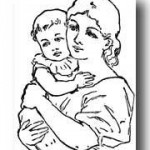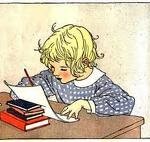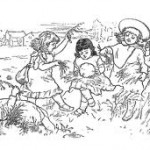(This article is adapted from a 3-part blog post series that I wrote for First Heralds in August 2011.)
Interest in Charlotte Mason’s educational approach has exploded within the homeschooling community in the last 15 years. We seem to love the idea of picture studies, narrations, and pretty books of centuries. We recognize the respect Mason extended to children, and this feels right to us. But there is more to it than that.
What exactly does it mean to educate our children following Charlotte Mason’s ideas about learning? What is a Charlotte Mason education?
Here I offer a brief overview of:
- The starting point of Mason’s educational philosophy,
- The principles upon which her method is based, and
- The key features of her method as practically applied.
In order to really enjoy and understand Charlotte Mason’s philosophy, you must take a long, leisurely country drive through it. This brief article will be more like a blur in the last stretch of the Grand Prix! Sometimes, though, brevity can suit our purposes.
I. Mason’s Starting Point: Children Are Born Persons
 Charlotte Mason lived during the waning years of the Victorian era, but she was no typical Victorian lady. Her method was revolutionary partly because it begins with a philosophical starting point that was counter-cultural in her day: children are born persons and deserve to be treated with same respect as all persons. She writes, “The fact seems to be that children are like ourselves, not because they have become so, but because they are born so.” A Philosophy of Education, 46 (emphasis mine).
Charlotte Mason lived during the waning years of the Victorian era, but she was no typical Victorian lady. Her method was revolutionary partly because it begins with a philosophical starting point that was counter-cultural in her day: children are born persons and deserve to be treated with same respect as all persons. She writes, “The fact seems to be that children are like ourselves, not because they have become so, but because they are born so.” A Philosophy of Education, 46 (emphasis mine).
Children bear the divine image of God; they are capable of expressing and reflecting Godly attributes. Children are thus born whole persons, and not formless lumps that need molding in order to become valuable. Like all human beings, they possess a natural yearning for God and desire for knowledge. This is no accident. This hunger is God’s very image present in the soul of every human — present from birth– calling us out of ourselves to seek Him, to seek Truth and Beauty.
We cannot, then, deny the dignity of the child, a dignity that must be protected no matter the child’s intellectual abilities or socio-economic status. When we attempt to pour information into a child as if he were an empty pot that needs filling, we violate that dignity. When we crassly overemphasize achievement, grades, and educational outcome, we violate that dignity. Because of their divine birthright, children don’t have to do anything or become anything to be complete. Children deserve to be respected for who they are, not for what or who they could potentially become.
From this starting point — that children are born persons because they reflect the image of God — the rest of Mason’s educational theory flows effortlessly. Narration is not the starting point. Short lessons are not the starting point. Living books are not the starting point. Children are born persons: this is the starting point. Realizing this was a turning point in my understanding what Charlotte Mason was up to nearly a century ago in the English countryside.
Author Jack Beckman explains that Mason’s starting point reveals her assumptions about the nature of the learner. See Jack Beckman, “The Child Is a Person” in When Children Love to Learn, 58-61. Any teacher’s or parent’s view of or assumptions about the learner affects how she answers questions about why she is teaching and what should be taught. I doubt many teachers really examine their assumptions about their students, but those assumptions drive their choices, attitudes, and feelings every day.
If the teacher believes the learner is incomplete (or even defective) or needs to be molded into the teacher’s own image, she will answer these questions one way. If the teacher believes the learner just needs to be filled up with the right facts, she answers these questions in another way.
If the teacher, like Charlotte Mason, sees the child full of “vast potential” (though limited by “ignorance and inexperience”), she will quite naturally see that they deserve the freedom to feast on the best “mind food” balanced with the loving encouragement they need to accept their responsibility to others, to God, and to themselves. The child should be an active participant in his own learning, rather than a passive recipient of information poured into him from his betters.
II. Foundational Principles: Education is an Atmosphere, a Discipline, and a Life
 Charlotte Mason is famous for her motto: Education is an atmosphere, a discipline, and a life. With these three “instruments” a child can receive a real education, which is an education that not only stretches her mind but also nurtures her heart. She grows up in a home where she is cherished and inspired (atmosphere), where she is strengthened in virtue (discipline), and where she is surrounded with noble books and ideas (life).
Charlotte Mason is famous for her motto: Education is an atmosphere, a discipline, and a life. With these three “instruments” a child can receive a real education, which is an education that not only stretches her mind but also nurtures her heart. She grows up in a home where she is cherished and inspired (atmosphere), where she is strengthened in virtue (discipline), and where she is surrounded with noble books and ideas (life).
The Atmosphere of Environment: By “atmosphere” Mason meant the spiritual, intellectual, and physical environment in which the child lived and learned. A child can learn best in an atmosphere in which she knows she is valued and cherished. Mason objected to empty moralism and motivators like fear and rewards.
Instead we should ensure our children grow up in an environment where:
- they are surrounded with the best of ideas and culture,
- they have plenty of free time for play, and space to make lots of noise,
- they are respected for who they are rather than for who they might become,
- they are given work appropriate for their developmental level, and
- they are surrounded with beauty and laughter.
Homeschoolers appreciate Mason’s confidence in the family as a locus of true education. Mason viewed the natural environment of the family as superior to any superficial or contrived educational environment.
Family life will expose children to many different people and experiences. The child living with her siblings and parents lives through illnesses and revivals, comes to know her garden and its inhabitants, and overhears dinner conversations between children and adults alike. This child observes the comings and goings of friends and extended family, and witnesses the celebration of birth and the mourning of death. Mason believed that this natural and dynamic exposure was critical to becoming truly educated.
The Discipline of Habit: In order for children to thrive in relationships with others, they must form the right habits. It is our responsibility to foster good habits in our children from birth. Mason rejected child training based on fear or force. Our goal is to educate the conscience of the child so she becomes self-disciplined. She does the right thing simply because it is right and not because she is fearful of punishment or wants a star on a chart.
The Life Found in Worthy Ideas: Mason believed that ideas were spiritual in origin, and that the best ideas could be found in “living books” and in great art and music. These worthy ideas feed a child’s mind just as good food nourishes her body. Mason objected to educational “twaddle” – dumbed down books that lack inspiration or imagination. She also believed children should have access to outdoors every day and should be given the chance to appreciate the natural world.
III. Practical Applications of Mason’s Philosophy
 I’ve discussed Charlotte Mason’s philosophical starting point in and the building blocks of her approach. We turn now to some of the practical applications of her philosophy. In short: What do you teach? How do you teach it?
I’ve discussed Charlotte Mason’s philosophical starting point in and the building blocks of her approach. We turn now to some of the practical applications of her philosophy. In short: What do you teach? How do you teach it?
Here I limit my descriptions to some of Charlotte Mason’s most distinctive applications. Need more info? My favorite resources for answering the “how” questions of homeschooling in the Charlotte Mason tradition are Catherine Levison’s how-to manuals. But, as mentioned above, sometimes a simple snapshot is just what we’re looking for!
Narration: Narration is the simple act of retelling what has been read, heard, or seen. A child might narrate what she has read or heard in literature or history, or something she has seen on a nature walk or during a picture study.
Narration is a cross-disciplinary method of helping a child to:
- pay attention to what she is learning,
- process and retain that information,
- filter out irrelevant information,
- pay attention to significant detail, and
- assimilate the ideas she has heard or experienced.
Through the process of narration, a child demonstrates real knowledge about something. If she is able to narrate with force and clarity, then she really knows something about the subject. Narration is a much better indicator of comprehension than completed worksheets.
Living Books: Living books have real literary power. They are written by inspired and imaginative authors. Children enjoy living books, because they appeal to their hearts and emotions — not just their heads. Living books are written with lively and beautiful language. Children and adults alike can remember what they’ve read or heard in a living book. Educational textbooks are not living because they present facts in a wooden, dead style. This doesn’t mean we can never use a textbook, but we should be aware of their limitations. Furthermore, we shouldn’t allow a child’s tastes to dictate book selections: A child may love living books, but he may also like “twaddle”.
Century Books: The Century Book is a binder or bound book that holds the child’s drawings, narrations, or other recordings about historical events or persons. In the Charlotte Mason classroom, students wouldn’t begin keeping a Century Book until the 5th grade (about age 10), but many families begin simple books at earlier ages, or they keep family century books. The Century Book is kept in chronological order, even when the child isn’t studying history chronologically. Beyond that, there’s no right way to keep a century book. Some people have a binder with one century per page, with the child entering small sketches or notations about things learned in her readings in literature, history, art appreciation, science, etc. Some people have a more flexible format.
The goal is to get into the habit of recording events and people in the Century Book so that the child gets a sense of the grandeur of history. She will begin to make connections between people and events. Catherine Levison has an excellent chapter on Century Books in her book More Charlotte Mason Education. Many websites offer downloadable templates for the Century Book, either for free or for purchase.
Nature Study: Most homeschoolers are familiar with Charlotte Mason’s approach to nature walks. We like Mason’s emphasis on field study, especially in the early years. She insisted that young children explore the natural world with little interference from adults. The parent should educate herself about basic botany and should be prepared to answer questions if they arise. While the parent is there to direct and guide, the goal is not to lead a guided lecture on some specific aspect of the natural world. (This doesn’t mean the child hasn’t read books about plants, animals, etc., but the nature walks should be as free as possible from lecturing or adult direction.) Mason’s approach was to take the children on a nature walk one afternoon a week, allowing them to delight in the natural world and its creatures. Some families take long walks once a week and/or shorter walks daily. The children collect things from their walks and record drawings or narrations in nature journals.
Picture Study: In the Charlotte Mason tradition, art appreciation doesn’t require becoming an expert on the various schools of art; it is about acquiring a “reverent knowledge” of great art. We first read the children a brief biography about the artist, then we present a copy of one of the artist’s paintings to the children. In our house, we pass around one copy of the print, but ideally each child would have his own copy to hold. We allow the children plenty of time to study the painting so they get a feel for the basic aspect of the painting and also its details. We can ask them to close their eyes to see if they can see the painting still. If they can’t, they study the painting a little longer. We then ask the children to respond to what they have seen and experienced. We display the painting for a week, then move on to another painting by the same artist. We stay with one artist for 6 to 8 weeks before moving on to a new artist. In this way, the child comes to know the artist’s works intimately.
This introduction is necessarily brief, but I hope it shows how balanced, intuitive, and sensible her method is. It works because it’s based on the truth. If you are very curious about Charlotte Mason’s educational approach, then I hope you’ll continue your investigations by reading one or more of the books available that discuss her ideas and educational approach. You’ll gain a clearer understanding of what you are meant to do and why you’re doing it. My personal favorites of the many terrific books available:
- For the Children’s Sake by Susan Schaeffer Macauley (Inspirational. After reading this book, you’ll feel you’ve stumbled upon something important. This book is very good on answering the “why” questions, but less helpful for telling you exactly “what” you are meant to do.)
- When Children Love to Learn edited by Elaine Cooper (An erudite collection of essays. This book was a turning point in my getting the “big picture” of Mason’s theory. The intended audience is the professional classroom teacher, but homeschoolers have also found this book very helpful.)
- Real Learning: Education in the Heart of My Home by Elizabeth Foss (Written by a Catholic homeschooling mom; Foss is unattached to any particular philosophy and clearly seeks the truth in whatever approach she uses to guide her children; excellent chapter on avoiding burnout.)
- A Charlotte Mason Education and More Charlotte Mason Education by Catherine Levison (This homeschooling mom has lived the Charlotte Mason life. She knows her stuff. Her little books cover the various subjects very succinctly. Very good on anwering your “what” and “how” questions but the above books are stronger on answering “why” questions.)
Happy learning!
